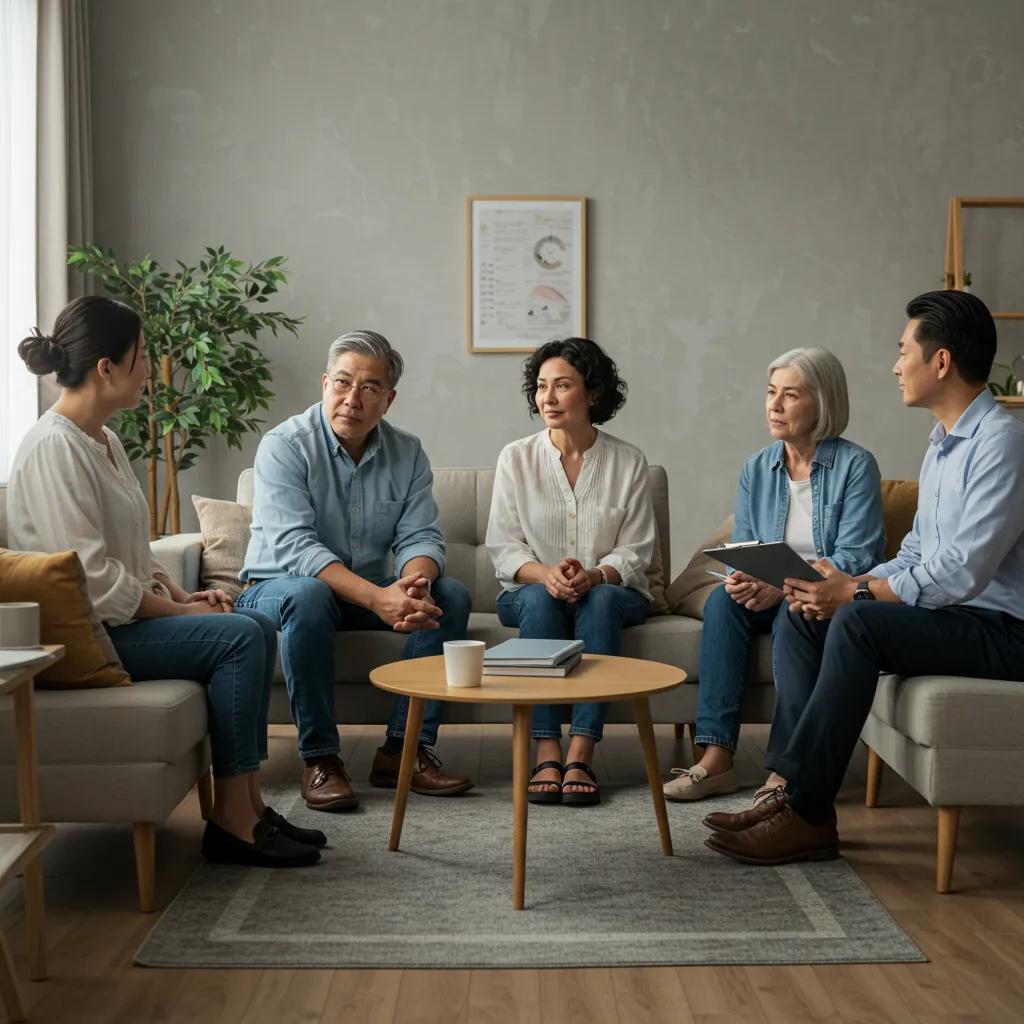How Family Group Therapy Works: A Comprehensive Guide to Benefits, Types, and Techniques
Family group therapy is a form of psychotherapy where multiple family members attend sessions together to address relationship patterns, improve communication, and solve shared problems. It works by shifting focus from one individual’s symptoms to interactional patterns, using structured interventions that target communication, roles, boundaries, and problem-solving within the family system.
Readers of this guide will learn what family group therapy is, who benefits, the major therapeutic models in use, a step-by-step look at typical session flow, and measurable ways to sustain gains after therapy. Many families seek help for adolescent behavioral issues, substance use, trauma, or grief; this article maps practical techniques, sample activities, and metrics clinicians use to track progress. We will compare structural, systemic, CBT-informed, and multi-family approaches, present session-level walkthroughs and exercises families can practice between meetings, and offer a checklist for finding a qualified therapist or program. Understanding these elements prepares families to make informed decisions and to partner effectively with clinicians committed to lasting change.
What Is Family Group Therapy and Who Can Benefit?
Family group therapy brings family members together in a shared therapeutic context to identify and change repetitive interaction patterns that maintain distress. The method leverages real-time interactions as both the target and the vehicle of change, using therapist-guided enactments and feedback loops to alter communication, roles, and boundaries. Families benefit because the therapy treats relational dynamics as causal rather than viewing distress as solely intrapersonal, which often produces broader, more sustainable change. Below we define core features, show how it differs from individual therapy, and list common populations who typically benefit.
What defines family group therapy and how does it differ from individual therapy?
Family group therapy is defined by its systemic lens: the family unit is the primary client, and the clinician observes and intervenes in relational patterns rather than focusing only on one person’s internal symptoms. This mechanism works by making interactional sequences visible—therapists use enactment, circular questioning, and boundary-setting to reveal how behaviors feedback into the system. Compared with individual therapy, family group therapy places emphasis on communication exchanges, role negotiation, and co-created solutions that change the environment maintaining problems. Understanding this systemic focus helps families anticipate that goals will target shared routines and agreements rather than only individual insight, which leads naturally into who typically benefits from this approach.
Who is the ideal audience for family group therapy?
Family group therapy most often helps families where relational patterns contribute to recurring problems rather than isolated pathology in one member. Populations that frequently benefit include families with adolescents displaying behavioral issues, households coping with substance use disorder, families processing collective or intergenerational trauma, and households facing complicated grief or major life transitions. The approach also adapts to diverse family configurations—blended families, single-parent households, and extended kin systems—because it targets patterns across relationships rather than assuming a nuclear family form. Knowing these target audiences clarifies when systemic, relational work will likely yield more durable outcomes than individual treatment alone.
How does family group therapy support diverse family structures and challenges?
Family group therapy supports nontraditional family structures by centering interventions on roles, expectations, and communication rather than on fixed family labels; clinicians map who participates in decision-making and caregiving and tailor interventions accordingly. Cultural responsiveness is integrated by eliciting family narratives, values, and power dynamics, then translating therapeutic techniques into culturally congruent practices that respect norms while promoting healthier interactions. Practical adaptations include flexible session formats (e.g., including extended relatives or using hybrid in-person/remote attendance) and tailoring language and psychoeducation to cultural frameworks. These adaptations ensure systemic interventions remain relevant and accessible across a wide range of family configurations, which sets up the next section on the concrete benefits such work produces.
What Are the Key Benefits of Family Group Therapy?

Family group therapy produces measurable improvements across communication, conflict resolution, emotional support, and resilience by targeting relational mechanisms directly. The approach reduces symptom maintenance by altering interactional sequences, increases shared problem-solving capacity, and strengthens family-level coping strategies that protect against relapse or recurrence. Below are explicit benefit categories with practical outcomes and examples families can relate to, followed by a comparison table that links each benefit to mechanisms and observable results.
Family group therapy delivers several interrelated benefits:
- Improved Communication: Families learn structured dialogue skills that reduce misattunement and increase clarity.
- Enhanced Conflict Resolution: Therapists teach negotiation and boundary-setting tools that de-escalate disagreements.
- Stronger Emotional Support: Shared processing builds validation routines and coordinated responses to distress.
- Increased Resilience and Coping: Families develop contingency plans and mutual strategies for stress and relapse prevention.
These benefits operate through concrete mechanisms—behavioral rehearsal, psychoeducation, and shared practice—which we outline in the table below to make outcomes and pathways explicit.
| Benefit | Mechanism | Practical Family Outcome |
|---|---|---|
| Improved Communication | Structured dialogues, active listening practice | Clearer turn-taking, fewer interruptions, more accurate shared understanding |
| Enhanced Conflict Resolution | Problem-solving steps, behavioral contracts | Shorter, contained conflicts and negotiated agreements with follow-up plans |
| Stronger Emotional Support | Mutual validation, joint narratives | Increased comfort in sharing emotions and coordinated comfort strategies |
| Resilience and Coping | Relapse/contingency planning, role rehearsals | Family-level crisis protocols and earlier intervention when warning signs appear |
This table clarifies how therapy techniques translate into observable family outcomes. The mechanisms listed guide clinicians when choosing interventions tailored to each family’s primary challenges.
How does family group therapy improve communication within families?
Improving communication begins by introducing structured skills—active listening, “I”-statements, reflective summarizing, and time-limited turn-taking—so family members can practice safe exchanges and test new behaviors. Clinicians model and scaffold these skills in-session through role-plays and guided feedback, then assign brief, measurable homework (e.g., 10-minute daily structured check-ins) to consolidate practice. These exercises decrease reactive escalation, increase emotional attunement, and boost the accuracy of shared understanding, which in turn lowers conflict frequency. Practicing these skills between sessions accelerates generalization to everyday situations and prepares families for deeper problem-solving work.
In what ways does family group therapy enhance conflict resolution skills?
Conflict resolution in family group therapy relies on mapping conflict sequences, identifying triggers, and teaching stepwise problem-solving: define the problem, generate options, select solutions, and agree on accountability. Therapists often use behavioral contracts or negotiated agreements to formalize solutions and reduce ambiguity about roles and consequences. Short in-session experiments (e.g., guided negotiation with time limits) allow families to test new approaches while receiving coaching and containment. Over time, these skills reduce escalation, produce clearer expectations, and help families reestablish functional patterns after disagreements.
How does family group therapy strengthen family bonds and emotional support?
Therapy strengthens bonds by creating safe opportunities for shared narrative-building, mutual validation, and ritualized positive interactions that replace dysregulated exchanges. Interventions such as facilitated storytelling, gratitude rounds, or collaborative meaning-making exercises help families recognize strengths and recalibrate identity after stressful events. These activities create repeated positive experiences that counterbalance past invalidation and strengthen trust. When trust increases, families are more likely to coordinate caregiving, adhere to relapse plans, and sustain supportive routines over time.
What coping mechanisms and resilience skills are developed through family group therapy?
Family-level coping skills taught in therapy include emotion regulation strategies (grounding, paced breathing), mutual contingency planning (who to call during crisis), and problem-focused coping such as task delegation and resource mapping. Clinicians help families create written contingency plans that specify warning signs, immediate responses, and recovery steps, which reduces ambiguity during crises. Rehearsal of these plans in-session increases confidence and shortens response time when difficulties arise. Over months, families convert ad-hoc responses into predictable systems that reduce dysfunction and accelerate recovery when stressors occur.
What Are the Different Types and Models of Family Group Therapy?
Several established models inform family group therapy; each model emphasizes different mechanisms and techniques depending on clinical targets and family needs. Structural approaches focus on boundaries and subsystems, systemic models examine circular causality and feedback loops, CBT-informed family therapy integrates cognitive and behavioral techniques across members, and multi-family group therapy leverages peer learning and shared psychoeducation. The table below compares these models so families and clinicians can align choice of approach with presenting problems and goals.
| Model | Core Focus/Technique | Typical Use / Example |
|---|---|---|
| Structural Family Therapy | Boundaries, subsystems, enactment | Useful when family roles are rigid or boundaries blurred (e.g., parental coalition) |
| Systemic Family Therapy | Circular causality, feedback loops, reframing | Applied when patterns of interaction sustain symptoms across members |
| Cognitive Behavioral Family Therapy | Cognitive reframing, behavioral experiments, skills training | Effective for families needing concrete homework and measurable behavior change |
| Multi-Family Group Therapy | Peer feedback, shared psychoeducation, group coaching | Recommended for stigma reduction and skill generalization across families |
| Process Group/Other Integrative Models | Group dynamics, emotion-focused techniques | Used when group cohesion and mutual support are primary goals |
This comparison helps readers understand which model aligns with specific clinical targets, from boundary restructuring to skills-based change.
What is Structural Family Therapy and how is it applied in group settings?
Structural family therapy, derived from Minuchin’s work, targets family hierarchies, boundaries, and subsystem organization by using enactments to surface hidden rules and reassign roles. In group settings, therapists prompt family members to enact typical interactions while the clinician intervenes to modify boundaries—encouraging parental leadership or supporting adolescent autonomy depending on needs. Techniques include unbalancing (temporarily shifting alliances to show alternative structures) and mapping subsystems with a genogram to reveal transactional patterns. These interventions reorganize family structure so daily routines and decision-making support healthier functioning.
How does Systemic Family Therapy address family dynamics?
Systemic family therapy addresses dynamics by treating problems as emergent from circular causality—where behaviors of one member evoke responses in others that perpetuate the issue. Clinicians use circular questioning and reframing to expose alternative interpretations and to break repetitive feedback loops. Tools like genograms and pattern-mapping help families see cycles of escalation and identify leverage points for change. By shifting the meaning attributed to behaviors and altering interaction sequences, systemic therapy reduces symptom-linked reinforcement and opens space for new relational patterns.
What role does Cognitive Behavioral Therapy play in family group therapy?
CBT-informed family therapy adapts cognitive and behavioral methods for the system by focusing on shared beliefs, behavioral experiments, and concrete skill-building across members. Techniques include collaborative problem-solving, behavioral activation for disengaged family members, communication training, and joint exposure or behavioral experiments to test assumptions. Homework assignments are structured and measurable, promoting accountability and observable progress. CBT’s emphasis on measurable targets and short-term behavioral change complements systemic and structural strategies to produce rapid improvements in functioning.
What is Multi-Family Group Therapy and how does it differ from single-family sessions?
Multi-family group therapy convenes several families in a shared group where psychoeducation, skill practice, and mutual feedback occur in a community context, creating social learning opportunities and normalizing struggles. Unlike single-family sessions that delve into intimate dynamics, multi-family groups emphasize peer coaching, role-modeling, and cross-family problem-solving, which can accelerate stigma reduction and broaden strategy repertoires. Activities often include shared psychoeducation modules, paired practice, and facilitated group problem-solving. When families need community support in addition to clinical input, multi-family formats amplify learning and sustainment.
Research indicates that multi-family group therapy can be effective in various settings, including primary schools, by fostering a supportive environment for shared learning and problem-solving.
The multi-family group therapy model is also being explored for its effectiveness in addressing specific adolescent issues, such as internet addiction, by leveraging shared experiences and support among families.
How does Revival Mental Health integrate evidence-based therapies in family group therapy?
Revival Mental Health offers Family Group Therapy as part of its Therapy Solutions within an intensive, residential mental health treatment framework located in Orange County, California. Their program integrates evidence-based therapies—specifically cognitive behavioral therapy (CBT), dialectical behavior therapy (DBT), and acceptance and commitment therapy (ACT)—alongside holistic modalities to support family involvement and relational change. Clinical care is delivered by a multidisciplinary team including psychiatry and master’s- or doctorate-level clinicians, and the residential model provides continuous clinical support to reinforce skills learned in group sessions. (revivalmentalhealth.com)
What Happens During a Typical Family Group Therapy Session?
A typical family group therapy session follows a predictable structure: assessment and check-in, focused work on a target interaction or skill, practice through enactments or role-play, and a debrief with homework assignments. Sessions leverage in-the-moment interactions to highlight patterns and rehearse new behaviors under therapist guidance, which accelerates learning compared with isolated individual interventions. In residential or intensive programs families can expect more frequent sessions and integrated support from a multidisciplinary team, which reinforces practice and allows rapid troubleshooting of barriers. The following sections break the session into phases, list common activities, and explain therapist and participant roles so families know what to expect.
| Session Phase | Activities | Time / Goal |
|---|---|---|
| Intake & Goal Setting | Family interview, genogram, symptom mapping | 30–60 min / Establish priorities and measurable goals |
| Check-in | Brief updates from members | 10–15 min / Surface current stressors and maintain continuity |
| Focused Intervention | Enactment, skill teaching, psychoeducation | 25–40 min / Target main pattern or skill practice |
| Practice & Homework | Role-play outcomes, assign tasks | 10–15 min / Reinforce skills between sessions |
| Debrief & Planning | Summarize gains, set next steps | 5–10 min / Consolidate learning and accountability |
This phase breakdown clarifies typical time allocations and clinical intent so families can anticipate how each session advances therapeutic aims.
How are initial assessments and goal setting conducted in family group therapy?
Initial assessment typically begins with a comprehensive family interview and history-taking to map roles, stressors, and patterns; clinicians often use genograms and symptom checklists to organize information. Goal setting is collaborative: the therapist translates family priorities into specific, measurable, achievable, relevant, and time-bound (SMART) goals that are revisited regularly. Assessment tools balance quantitative measures (family functioning scales) with qualitative narratives to capture both objective and subjective change markers. Clear collaborative goals create a shared roadmap that orients subsequent sessions and enables transparent tracking of progress.
What is the typical structure and flow of a family group therapy session?
A standard 60–90 minute session typically begins with a 10–15 minute check-in, followed by a focused 30–40 minute intervention segment where the therapist facilitates an enactment or teaches a skill, then moves into 15–20 minutes of practice and homework planning, and ends with a 5–10 minute debrief. This predictable flow supports safety and allows families to attempt new behaviors within a contained timeframe. Therapists use time limits and explicit transitions to manage intensity and avoid escalation, which ensures learning while protecting members who may feel vulnerable. Clear structure also helps families practice applying skills outside the therapy room.
Which therapeutic activities and exercises are commonly used?
Common activities include role-plays to rehearse difficult conversations, genogram construction to trace relational patterns, circular questioning to reveal feedback loops, behavioral contracts for negotiated agreements, and psychoeducational modules that teach emotion regulation or relapse prevention. Each activity is selected for a targeted purpose—role-play builds skill fluency while genograms increase pattern awareness—and therapists pair each in-session exercise with brief between-session assignments to promote generalization. Frequency varies by need: skills practice might be weekly, while psychoeducation occurs in blocks; clinicians calibrate intensity to family readiness. These activities create both insight and practiced alternatives to old patterns.
Systemic family therapy often incorporates behavioral skill-building techniques, which involve psychoeducation and in-session practice, to enhance communication and problem-solving abilities within families.
What is the therapist’s role in facilitating family group therapy?
The therapist’s role is to observe interactional patterns, contain emotional intensity, model new communication strategies, and select interventions that target identified leverage points within the family system. Clinicians balance directive techniques (e.g., structuring an enactment) with non-directive facilitation (e.g., eliciting mutual reflections) to engage all members and maintain safety. Competent facilitation includes setting clear ground rules for respectful interaction, enforcing boundaries when escalation occurs, and adjusting interventions according to cultural and developmental needs. Families can look for therapists who demonstrate both technical skills and the capacity to create predictable, contained sessions.
How do participants engage and contribute during sessions?
Participants are expected to engage actively by sharing observations, practicing assigned skills, and completing brief homework exercises; confidentiality, respectful listening, and adherence to session agreements are foundational norms. Preparation tips include reflecting on a recent interaction to bring as the focus topic, practicing one communication skill beforehand, and designating time post-session to review homework together. Younger or resistant members may participate through structured roles or shorter speaking turns to build engagement gradually. Active, consistent participation accelerates progress because therapy changes interactional contingencies that maintain problematic behavior.
How Does Family Group Therapy Address Specific Family Challenges?
Family group therapy is tailored to address specific clinical presentations by selecting interventions that directly target the relational mechanisms sustaining the problem. For adolescents, therapy combines parent management strategies with in-session enactments; for substance use disorders, families work on relapse prevention and boundary-setting; for trauma, clinicians emphasize stabilization, pacing, and safety; and for grief, therapy incorporates shared meaning-making and ritual. The subsections below describe typical interventions and expected outcomes for these common challenges.
How does family group therapy support adolescent behavioral issues?
When addressing adolescent behavioral problems, therapists combine parent management training with joint family sessions that reassign clear parental authority and consistent consequences. Techniques include behavioral contracts that specify rewards and consequences, structured family meetings to rehearse problem-solving, and skill-building for emotion regulation in the adolescent. Expected improvements often include reduced externalizing behaviors, clearer routines, and improved school or social functioning over weeks to months. Early engagement of caregivers in consistent contingencies is a strong predictor of durable change.
What role does family group therapy play in substance use disorder recovery?
In substance use disorder recovery, family group therapy focuses on relapse prevention, clarifying boundaries, and strengthening supportive responses to triggers rather than enabling behaviors. Families develop contingency plans that specify monitoring, safe housing or support steps, and responses when warning signs appear; clinicians also teach communication strategies for addressing triggers without escalating conflict. These interventions reduce environmental risk factors and increase accountability while supporting recovery efforts. Family engagement in relapse planning improves adherence and reduces the likelihood of isolated crises.
How can family group therapy aid trauma recovery within families?
Trauma-informed family group therapy emphasizes safety, pacing, stabilization, and psychoeducation about trauma responses to prevent retraumatization during joint work. Clinicians prioritize creating predictable session structures, grounding techniques for regulation, and gradual processing that respects individual readiness; family-level tasks focus on repair, validation, and co-regulation strategies. Interventions aim to rebuild trust and to integrate traumatic narratives into a shared story that reduces isolation. This careful sequencing—stabilize, educate, then process—protects members while fostering collective recovery.
In what ways does family group therapy help families cope with grief and loss?
Family group therapy helps families process grief by facilitating shared storytelling, rituals, and meaning-making that integrate loss into family narratives and daily routines. Therapists guide structured exercises such as legacy-building activities, joint memorial planning, and safe expression rounds to normalize varied grief responses and to coordinate supportive behaviors. Over time, these practices maintain connection to the lost person while enabling functional reorganization of roles and responsibilities. The goal is mutual support and adaptive routines that honor loss while restoring daily functioning.
How Is Success Measured and Sustained After Family Group Therapy?
Success in family group therapy is measured with a combination of quantitative scales and observable behavioral indicators, and sustained through aftercare planning, booster sessions, and maintenance routines. Clinicians track outcomes using validated family functioning measures, symptom scales, and goal attainment scaling, while families monitor concrete changes like reduced conflict frequency or improved school/work functioning. Sustaining gains requires explicit maintenance strategies—scheduled check-ins, practiced rituals, and community supports—that translate in-session learning into lasting habits. Below are metrics commonly used and practical actions families can take to preserve progress.
What metrics and indicators show progress in family group therapy?
Progress can be tracked using standardized instruments (family functioning scales, caregiver stress measures, symptom checklists) along with behavioral indicators such as decreased conflict incidents, improved attendance/performance at school or work, and completion of agreed-upon tasks. Clinicians may use goal attainment scaling to quantify individualized objectives and show incremental change over time. Qualitative reports—greater emotional safety, clearer communication, and increased problem-solving—also serve as meaningful indicators of success. Combining objective scales with functional markers gives a comprehensive view of therapeutic impact.
How can families maintain improvements post-therapy?
Families maintain improvements by scheduling regular practice of learned skills, setting brief booster check-ins (e.g., monthly or quarterly), and keeping written contingency plans and communication rituals in place. An actionable maintenance checklist includes: continued structured family meetings, redoing brief role-plays quarterly, monitoring early warning signs, and assigning rotating responsibility for crisis response steps. Embedding skills into daily routines—like a weekly check-in or gratitude ritual—keeps skills active and reduces relapse risk. Routine practice and timely booster sessions transform short-term gains into long-term habits.
What role does ongoing support and follow-up play in long-term recovery?
Ongoing support—through booster sessions, peer groups, or community resources—strengthens resilience by refreshing skills, troubleshooting setbacks, and maintaining accountability over time. Periodic follow-up allows clinicians to recalibrate goals, address new stressors, and reinforce successful strategies before problems re-escalate. Typical follow-up cadence varies by need but often includes short booster sessions at 1–3 months and then as-needed check-ins tied to milestones or stressors. Continuous links to support networks and planned aftercare help families navigate transitions and protect against relapse.
How to Find the Right Family Group Therapist and Therapy Program?
Selecting an appropriate therapist or program requires attention to clinician qualifications, treatment model fit, program features that support continuity of care, and cultural competence. Families should look for licensed clinicians with training in family therapy models and group facilitation skills, evidence-based modalities in use, and clear aftercare planning. Below is a checklist families can use when evaluating therapists and programs, followed by a concise, factual example of how one residential provider structures intensive family involvement.
- Check qualifications: Licensed clinician with family therapy training and group facilitation experience.
- Confirm model fit: Ask which family therapy models the clinician uses and why they suit your goals.
- Assess program features: Look for evidence-based modalities, measurement practices, and aftercare planning.
- Evaluate logistics & culture: Ensure the program’s format, scheduling, and cultural approach match family needs.
This checklist helps families ask targeted questions and compare options based on therapeutic fit rather than marketing claims.
What qualifications and experience should a family group therapist have?
Ideally, a family group therapist will be a licensed clinician with specialized training in family therapy models and demonstrated group facilitation experience; additional experience with trauma-informed care and substance use disorders is desirable where those issues are central. Clinicians should be able to describe their approach, measurement practices, and examples of typical session flow, as well as how they handle safety and confidentiality in group contexts. When interviewing potential therapists, families can ask for specific examples of interventions used for similar cases and how progress is tracked. These qualifications indicate a clinician’s capacity to manage complex relational dynamics safely and effectively.
How does Revival Mental Health ensure personalized and intensive family therapy?
Revival Mental Health provides Family Group Therapy within an intensive, residential treatment model in Orange County that emphasizes family involvement, individualized treatment planning, and a continuum of care. The program integrates evidence-based therapies—specifically cognitive behavioral therapy (CBT), dialectical behavior therapy (DBT), and acceptance and commitment therapy (ACT)—alongside holistic modalities to support family involvement and relational change. Clinical care is delivered by a multidisciplinary team including psychiatry and master’s- or doctorate-level clinicians, and the residential model provides continuous clinical support to reinforce skills learned in group sessions. (revivalmentalhealth.com)
What should families expect when starting therapy at Revival Mental Health?
Families beginning therapy in a residential, intensive program can expect an initial intake that informs an individualized treatment plan, multidisciplinary clinical involvement, and ongoing scheduling of family sessions as part of a broader therapeutic package. The setting supports frequent opportunities for skills practice with 24/7 psychiatry and clinician availability, which allows rapid adjustment of plans and immediate support during crises. Programs emphasize evidence-based therapies together with holistic modalities and coordinate aftercare to maintain progress after discharge. Families should anticipate structured involvement, clear goal-setting, and collaborative planning for post-program transition.





